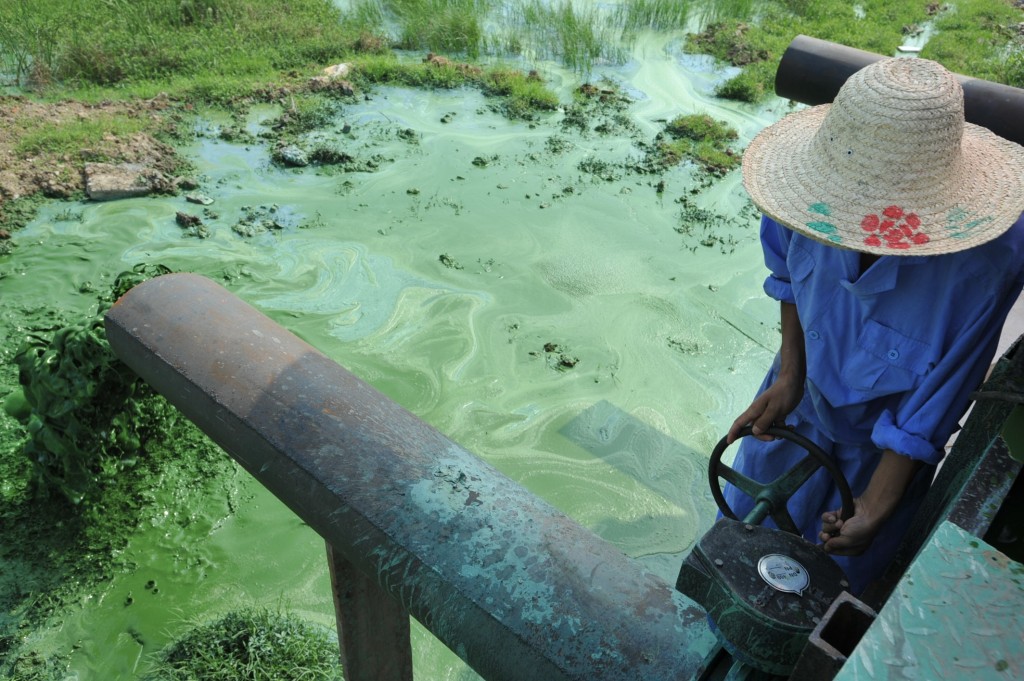The issue of water quality in China was highlighted in the media after the contamination of the water supply in Handan, Hebei province in January. It made headlines for two principle reasons. Firstly, the scale of the contamination—nearly nine tonnes of aniline were released into the Zhuozhang River—meant that the leak affected the drinking water supply of hundreds of thousands of people. Xinhua reported that the levels of aniline were 720 times the acceptable level in water samples taken from the Shanxi/Hebei border. Secondly, the way that the incident was handled caused public outrage as provincial government officials of Changzhi City, Shanxi, where the leak occurred, did not publicly announce it for several days causing concern among Handan citizens who feared they may have already ingested contaminated drinking water.
Simon Spooner, Principal Consultant at Atkins Water & Environment and Chair of the Beijing Water Working Group, addresses the issues that the Chinese Government faces in their challenge to provide clean, sustainable sources of water to the population, and outlines the crucial role that the EU is already playing in helping them to achieve this goal.
 The rivers, lakes and groundwater in most areas of China are severely depleted, contaminated and overexploited. This reduces their capacity to support a healthy ecosystem as well as a happy and healthy human population. Urgent action is required to redress this imbalance between the demands being placed on the freshwater resources of China and the ability of the natural systems to renew, recover, refresh and self-purify.
The rivers, lakes and groundwater in most areas of China are severely depleted, contaminated and overexploited. This reduces their capacity to support a healthy ecosystem as well as a happy and healthy human population. Urgent action is required to redress this imbalance between the demands being placed on the freshwater resources of China and the ability of the natural systems to renew, recover, refresh and self-purify.
These problems are fully recognised by the Chinese Government and policies and laws have been put in place to improve the situation, drawing on the best experiences of turning around water quality, especially from Europe. But these are complex problems that require massive long-term investment, as well as a shift in people’s attitude towards the environment.
The general policy and legal framework requires detailed regulations, administrative guidance, technical tools, human capacity and enthusiasm to implement. However, this body of systematic approaches is now building and the situation shows signs of improvements in some areas.
The causes of the problems are from all areas of society—agriculture, industry and urban development—and they have been compounded by the fact that dealing with water pollution on an everyday basis is not treated as a high priority. In agriculture excess fertilisers, pesticides and animal wastes are allowed to run into the rivers and seep into the ground. In industry costs are saved by minimising expenditure on non-productive environmental protection services.
In cities the wastewater treatment is an unglamorous job that only benefits the people downstream. But this is not the full picture. Clean water is the most undervalued commodity and failure to secure access to clean water will lead to problems in food production, health problems and ultimately social instability and risks to national security.
For a long time China has run campaigns to reduce wasteful pollution from agriculture, set discharge standards for industry, close the most polluting enterprises, and require the construction of wastewater treatment plants for cities. Such actions help but if the ultimate environmental improvement goals are not achieved then it is difficult to enforce and since such actions are not directly connected with actual environmental outcomes they cannot be guaranteed to achieve a healthy environment.
The current approach is to define each body of water and set environmental quality standards, not just chemical standards bit also for the biology and ecosystem it supports. This results in much better indicators and the problem is broken down into manageable units. In order to achieve the target, the carrying capacity—the amount of pollution that any part of the environment can absorb and still meet the targets—is calculated. Measures can then be planned to reduce total pollution loads to fall within this value.
Though simple in principle this process is very complex to implement, requiring meticulous monitoring, data management and analysis and then enforcement through regulation and permitting systems. These full systems do not yet exist but a great deal of work is going into the development of them.
Setting the biological and ecological targets is a major step forward in China’s environmental management. Much work is already underway to develop a comprehensive river health assessment system based on a five-part combined analysis. This analysis monitors each river section to asses: 1) chemical water quality; 2) flow regime; 3) ecological and biological biodiversity status; 4) the physical structure of the river channel; and 5) the social function that the river provides.
 Ultimately the goal is to integrate management of water quantity and quality to within healthy and sustainable levels that will support the most productive ecological system for people to live within.
Ultimately the goal is to integrate management of water quantity and quality to within healthy and sustainable levels that will support the most productive ecological system for people to live within.
The main policy approach for achieving these goals is set out in the ‘Three Redlines’ policy which defines: 1) water use allocations for each region and user to control total water use to be within renewable resource capacity; 2) targets for water use efficiency in industry in terms of water use per unit of GDP and in agriculture in terms of proportion of abstracted water actually reaching the crops; and 3) total pollution load allocations to each section of the river, to be within the carrying capacity of the river and meeting the water quality standards for the defined water functional zones within a timetable with stages up to 2030.
Based on experience elsewhere in the world, realising these goals for water management in China will require the development, and enforcement, of a permitting system to control the abstraction and discharge of surface and groundwater. In Europe and the US such permitting systems are based on procedural processes supported by technical guidelines, which are enforced through environmental law in courts operating at local and national levels.
In China such environmental law enforcement is not yet well established and the process of policy enforcement is much more through the Party and the cadre assessment processes, which set specific targets for senior officials to achieve with penalties for non-performance. Therefore a slightly different and unique approach needs to be taken in China to build an enforcement framework, encompassing both legal and political instruments.
As part of the programme for implementing the ‘Three Redlines’ and wider environmental improvement goals, China has set out national plans for the prevention of pollution, coordinating major technical and policy research programmes with the drafting and implementation of the 12th Five-Year Plan and a range of related river basin and sector plans.
These include the National 12th Five-Year Plan for Environmental Protection, the National 12th Five-Year Plan for Comprehensive Energy Saving and Pollution Discharge Reduction, Water Pollution Prevention Planning for Key Basins (2011-2015), National Environmental Protection Plan for Drinking Water Source, and the National Groundwater Pollution Prevention and Control Plan (2011-2020).
Together with other water quality management regulations these plans set out programmes for defining and implementing the pollution load allocation management system, abstraction and discharge licensing and the river health assessments. They also tackle other key issues such as protecting drinking water source areas, identifying key pollution source risks and groundwater pollution risk reduction.
Drinking water source areas are accorded specific protections to ensure that contamination is reduced and healthy and reliable supplies can be secured. Sudden pollution incidents, such as those resulting from accidents, illegal discharges from industry, mine tailing dam collapses or flooding washing pollution into the river are still very common in China and can cause great disruption, interruption of water supplies and ecological and human health impacts.
Systems are being put in place for the more effective detection, reporting and response planning for when incidents occur, but the most important thing is to prevent the incidents in the first place by identifying the sources of risk and then ensuring that measures are taken to minimise the chances of accidental spills and, if accidents do occur, reducing the risk of any pollution entering the river courses or soaking into the groundwater. This is a massive task, requiring the inspection, assessment and enforced modification of hundreds of thousands of industrial sites, large and small across China.
Even as surface water pollution issues are being tackled there remain huge problems of contaminated groundwater in aquifers (a body of saturated rock through which water can easily move). The assessment and remediation planning for this is just beginning but the first step is to ensure that there is awareness of the risks of polluting groundwater and that measures are taken to prevent further damage occurring. Once contaminated it is a long and difficult process to remediate the aquifers. Thus this will sadly remain as a legacy of the industrialisation of China.
In recognition of the enormity and seriousness of the water pollution issues faced China is greatly increasing investment in addressing the problem. Most developed counties have already gone through the process of implementing environmental protection and achieved massive reductions in water pollution, thus through exchange and cooperation China can make this same transition more rapidly.
The EU has been engaging with the Chinese Ministry of Water Resources and Ministry for Environmental Protection to assist with this process over the last five years through the River Basin Management Programme (RBMP) and now through the China Europe Water Platform, which help to drive the policy development process and implementation of integrated river basin management.
Further, Europe is engaging in joint research through the Environmental Sustainability Programme and through research projects under the European Commission’s Seventh Framework Programme (FP7) as well as, from next year, the new Horizon 2020 Programme. Specific opportunities are arising for European business to engage with the water investment programmes and the European Chamber of Commerce in China’s Water Working Group has been established to facilitate engagement with government programmes and to help build bridges between European and Chinese companies.
Atkins (www.atkinsglobal.com) is one of the world’s leading design, engineering and project management consultancies, employing some 17,700 people across the UK, North America, Middle East, Asia Pacific and Europe. It has the breadth and depth of expertise to plan, design and enable some of the world’s most technically challenging and time-critical infrastructure projects. In Asia Pacific, we have 1,200 staff located in offices in Hong Kong, Beijing, Shanghai, Shenzhen, Chongqing, Chengdu, Singapore, Sydney, Perth, Ho Chi Minh City and Kuala Lumpur.


What happened in Lanzhou, Gansu province recently drew the attention of all. It’s been about a week now. People have been lining up to get fresh water. The source for the water contamination seems to be oil leak from an old tank?
WELL, this IS a very complicated and complex issue to be solved! Hopefully, collaborations with other international organizations will speed up the process and push all the actions forward.